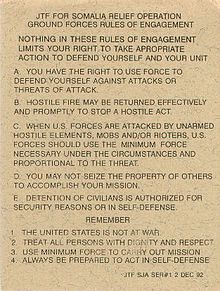Rules of engagement
The examples and perspective in this article may not represent a worldwide view of the subject. (April 2014) |

Rules of engagement (ROE) are the internal rules or directives among military forces (including individuals) that define the circumstances, conditions, degree, and manner in which the use of force, or actions which might be construed as provocative, may be applied.[1] They provide authorization for and/or limits on, among other things, the use of force and the employment of certain specific capabilities. In some nations, ROE has the status of guidance to military forces, while in other nations, ROE is lawful commands. Rules of engagement do not normally dictate how a result is to be achieved, but will indicate what measures may be unacceptable.[2]
While ROE is used in both domestic and international operations by most militaries, ROE is not used for domestic operations in the United States. Instead, the use of force by the U.S. military in such situations is governed by Rules for the Use of Force (RUF).
An abbreviated description of the rules of engagement may be issued to all personnel. Commonly referred to as a "ROE card", this document provides the soldier with a summary of the ROE regulating the use of force for a particular mission.[3]
Authoritative sources
While many countries have their own rules of engagement documents, many others do not. There are two primary international rules of engagement manuals that are internationally available: NATO ROE Manual MC 362-1 (restricted to NATO and Partnership for Peace countries); and the San Remo Rules of Engagement Handbook, which is freely available to all on the International Institute of Humanitarian Law (IIHL) website. Created for the IIHL by Commander Alan Cole, Major Phillip Drew, Captain Rob McLaughlin and Professor Dennis Mandsager, the San Remo ROE Handbook has been translated from its English original into French, Chinese, Arabic, Spanish, Hungarian, Russian, Bosnian, and Thai and several other languages.[4] Several countries have used the San Remo handbook as a model for creating their own ROE systems.[citation needed]
Training
The International Institute of Humanitarian Law in San Remo, Italy conducts rules of engagement training course at least once per year, usually in September. Taught by some of the world's foremost authorities on ROE, the course attracts students from around the globe. Similar training by the San Remo ROE drafting team is conducted for the United Nations,[5] staff colleges and other organizations as requested.
Violations
Often, violations of the laws of war are confused with violations of rules of engagement. Command responsibility is one means to distinguish between the two. The rules of engagement is a standard internal to the military, composed of orders that the military has deemed that its forces should follow during an operation. Treaties such as the Geneva Conventions that have been ratified by U.S. Senate are U.S. law under Article 6 of the U.S. Constitution. Likewise, the laws of war are part of international law, and also have the status of law, as recognized by the Supreme Court in The Paquete Habana. Breaches of treaties such as the Geneva Conventions and other laws of war might, therefore, fall outside of the ROE.
While some courts[citation needed] have found that an error in judgment in determining a hostile act or hostile intent is a breach of ROE, that conclusion constitutes an error at law on the part of the court[citation needed]. The question that must be asked in such cases is "Did the Soldier have an authority to use deadly force during this mission?" If the answer is yes, and the issue is self-defense, then attention must be turned to whether or not that force was reasonable and necessary in the circumstances. When a prisoner of war/detainee is held under captivity, that person is afforded special protection under international humanitarian law. If the detained person is abused or murdered, the violation is one of international humanitarian law or the international criminal law, not necessarily the ROE.[6] It is important to note that protections afforded by the Geneva Conventions are not limited to those captured. The Fourth Geneva Convention, for example, is composed of more than 150 articles all of which are devoted to the protection of civilian populations as well.
References
- ^ NATO MC 362/1
- ^ Cole, Drew, McLaughlin, Mandsager, San Remo Rules of Engagement Handbook (San Remo: International Institute for Humanitarian Law, 2009)
- ^ Cole, Drew, McLaughlin, Mandsager, San Remo Rules of Engagement Handbook (San Remo: International Institute for Humanitarian Law, 2009)p.71
- ^ iihl.org
- ^ "How are Rules of Engagement (ROE) prepared for United Nations peacekeeping missions?". Retrieved 30 August 2016.
- ^ Walzer, Michael (2015). Just and Unjust Wars. New York City: Basic Books. pp. 38–39. ISBN 9780465052714.
